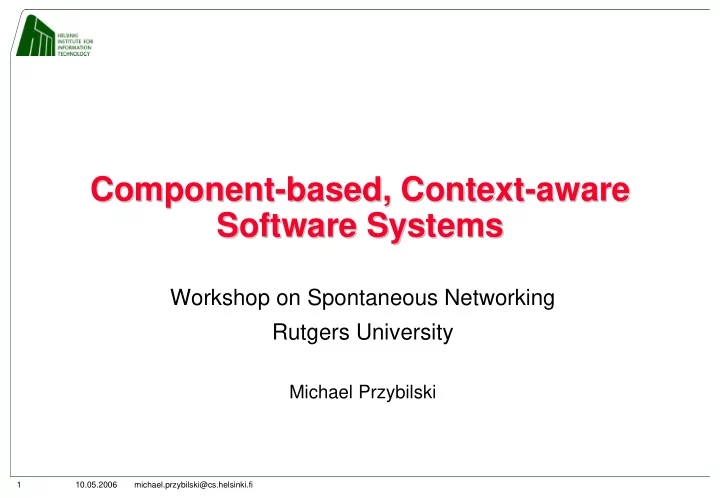

Component- -based, Context based, Context- -aware aware Component Software Systems Software Systems Workshop on Spontaneous Networking Rutgers University Michael Przybilski 1 10.05.2006 michael.przybilski@cs.helsinki.fi
Outline Outline • Motivation • Research Problems • Thesis • Example • Ongoing Work 2 10.05.2006 michael.przybilski@cs.helsinki.fi
Motivation Motivation • Increase of available context information Wireless information devices • Integrating increasing number of input and output devices • • Use for applications Explicit, potential • • Use of communication possibilities Remote devices • Number of devices • 3 10.05.2006 michael.przybilski@cs.helsinki.fi
Context and Context Reasoning Context and Context Reasoning • Context is any information that can be used to characterize the situation of an entity. An entity is a person, place, or object that is considered relevant to the interaction between a user and an application, including the user and application themselves. [A. Dey and G. Abowd, 1999] • Context-reasoning can be defined as deducing new and relevant information from the various sources of context-data 4 10.05.2006 michael.przybilski@cs.helsinki.fi
Challenges Challenges • Acquisition, processing and provision of context data • Rapidly changing and uncertain sources • Reuse Common steps • Context information • • Scalability • Flexibility 5 10.05.2006 michael.przybilski@cs.helsinki.fi
Software Components Software Components • A component is a coherent package of software artifacts that • can be independently developed and delivered as a unit, and • can be composed, unchanged, with other general components to build something larger • An interface is a description of a set of operations related to the external specification of a component. An interface consists of: • a set of operations that a component needs to access in its surrounding environment ( required interface ), • a set of operations that the surrounding environment can access on the given component ( provided interface ). • An operation is unit of functionality implemented by a component which may map to: • a method, • a function, • a procedure. 6 10.05.2006 michael.przybilski@cs.helsinki.fi
Distribution Distribution • Distributed processing / information sharing Nearby, resulting in a context-aware system • Remote • • Simple sensors • Wireless information devices Online processing • Groups of devices • Limited resources (processing, storage, networking, power, etc.) • • … • Servers High level of resources • Specialized • 7 10.05.2006 michael.przybilski@cs.helsinki.fi
Research Problems Research Problems • What are the minimum requirements for a distributed context management system, based on software components? • How can context reasoning mechanisms be efficiently integrated? • How can context-aware applications be built from software components? • How can additional requirements be efficiently integrated? 8 10.05.2006 michael.przybilski@cs.helsinki.fi
Scope Scope • Ranging from embedded devices, to mainframe computers • Context management on user’s wireless information device • Using remote devices for acquisition of context information and processing tasks (context reasoning) • Multi-bearer ad-hoc / P2P networks • Sensor-based context • Not specific to location context • Not specific to static contexts (device configuration) • Context-aware computing view • Not specific to semantic web • Flexible, component-based framework that can integrate additional QAs 9 10.05.2006 michael.przybilski@cs.helsinki.fi
Component Framework Component Framework • Functionality • Basic sensing • Learning + Inference • Provision of new context (prediction) • Abstraction of higher level of context (interpretation) • Store context data • Application logic • Basic communication • Compile-time / runtime extension with other QAs • Access list; restrict communication to specific other components • Privacy, security, (network) location 10 10.05.2006 michael.przybilski@cs.helsinki.fi
Components Components • 1-way communication (Messaging; Publish / Subscribe – Publish; synchronous / asynchronous / isochronous) Simple Msg. • 2-way communication (RPC; synchronous / asynchronous) Simple RPC • Optimization: combination of components, re-use of common functionalities at runtime 11 10.05.2006 michael.przybilski@cs.helsinki.fi
Simple Application Simple Application subscribe(select NULL where user = Michael, epoch = 1000) • The stolen / forgotten mobile phone • Sensor Beacon • Simple BT beacon • Attached to user • Transmit Freq. <= 1 Hz • Reasoning Reasoning • Beacon is with user • Mobile phone is owned by user • Should never be out of reach => stolen / forgotten • Application logic • Sound / display alarm if stolen / forgotten Application 12 10.05.2006 michael.przybilski@cs.helsinki.fi
Advanced “ “Application Application” ” Advanced • Inferring User Activity from 3D Acceleratometer • Steps Classification Feature Selection Feature Extraction Pre Processing Data gathering 13 10.05.2006 michael.przybilski@cs.helsinki.fi
Inferring User Activity from 3D Inferring User Activity from 3D Acceleratometer Acceleratometer • Components get(select activity from activity where user = Michael) subscribe(select x, y, z from acceleratometer where user = Michael, epoch = 10) Sensor Classifier subscribe(select variance, absoluteMagnitude from Feature-Selection where source = acceleratometer and user = Michael, epoch = 10) Preproc. FeatureExtr. FeatureSel. 14 10.05.2006 michael.przybilski@cs.helsinki.fi
Inferring User Activity from 3D Inferring User Activity from 3D Acceleratometer Acceleratometer • Sensor • 220 000 samples (100 Hz) • Preprocessor Sensorbox BT Link L2CAP Nokia 6600 • Feature Extraction • Feature Selection Node 2 • Variance, absolute Magnitude of Acceleration • Classifier Classifier FeatureSel. • Simple linear classifier • 300 samples for learning Node 1 • 300 samples for calibration Preproc. FeatureExtr. Sensor 15 10.05.2006 michael.przybilski@cs.helsinki.fi
Inferring User Activity from 3D Inferring User Activity from 3D Acceleratometer Acceleratometer Variance 0.35 0.3 0.25 0.2 Absolute Magnitude 0.15 0.1 0.05 0 0 10 20 30 40 50 60 70 80 *International Conference on Artificial Intelligence 2005 16 10.05.2006 michael.przybilski@cs.helsinki.fi
Other work Other work • Agent-paradigm • Distributed preprocessing • Integration of policy-based privacy and security • Autonomous Intelligent Systems: Agents and Data Mining, 2005 • Evaluation of reasoning mechanisms • Software framework for remote data gathering • WS / EJB components / WEKA • Pervasive Systems and Computing, 2005 17 10.05.2006 michael.przybilski@cs.helsinki.fi
Ongoing Work Ongoing Work • Further integration • iMotes (NesC) • Series 60 / 80 Mobilephones (Symbian C++) • JBoss Application Server • Communication • Ad-hoc (BT) and P2P (IP; 3G/GPRS / LAN) • Energy saving by remote processing • Reasoning mechanisms • Simple Bayesian networks, SVM 18 10.05.2006 michael.przybilski@cs.helsinki.fi
Questions? Questions? michael.przybilski@cs.helsinki.fi 10.05.2006 19
Recommend
More recommend